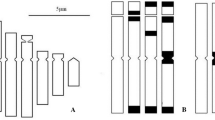Summary
-
1.
ThePentatomini, which constitute a single Tribe within one of the Subfamilies of the hemipteran FamilyPentatomidae, include an unusually large number of species. Though these species vary considerably in their size and color, they are very uniform in their essential external and internal morphology.
-
2.
Uniformity also characterizes such features in the Tribe as the chromosome number and meiotic behavior. But in the eleven species here investigated, this uniformity does not extend to the DNA content of the male meiotic cells, as determined by Feulgen cytophotometry.
-
3.
The lowest DNA content is found inThyanta which, in this respect, is well separated from an intermediate group whose DNA values vary around a mean that is roughly double the lowest amount. Some evidence is available that a still higher multiple of DNA may be represented in theAcrosternum-Nezara complex of species.
-
4.
In view of these cytochemical data, the multiplicity of species coupled with a striking uniformity of morphological and cytological features is provisionally explained on the basis of varying polyteny.
Similar content being viewed by others
References cited
Ansley, H. R.: A cytologioal and cytophotometric study of alternative pathways of meiosis in the house centipede (Scutigera forceps Rafinesque). Chromosoma6, 656–695 (1954).
Bauer, H.: Die Chromosomen vonTipula paludosa Meig. in Eibildung und Spermatogenese. Z. Zellforsch.14, 138–193 (1931).
Bayreuther, K.: Die Oogenese derTipuliden. Chromosoma7, 508–557 (1956).
Beermann, W.: Chromosomenkonstanz und spezifische Modifikationen der Chromosomenstruktur in der Entwicklung und Organdifferenzierung vonChironomus tentans. Chromosoma5, 139–198 (1952).
Blackburn, K. B.: Notes on the chromosomes of the duckweeds (Lemnaceae) introducing the question of chromosome size. Proc. Univ. Durham Philos. Soc.9, 84–90 (1933).
Caspersson, T.: Cell growth and cell function. New York: W. W. Norton 1950.
Darlington, C. D.: The chromosome as a physico-chemical unit. Nature176, 1139–1144 (1955).
Erdmann, R.: Experimentelle Untersuchung der Massenverhältnisse von Plasma, Kern und Chromosomen in dem sich entwickelnden Seeigelei. Arch. Zellforsch.2, 76–136 (1908).
Foot, K., andE. C. Strobell: A study of the chromosomes and chromatin nucleoli inEuschistus crassus. Arch. Zellforsch.6, 47–62 (1912).
Geitler, L.: Kernwachstum und Kernbau bei zwei Blütenpflanzen. Chromosoma1, 474–485 (1940).
—: Endomitose und endomitotische Polyploidisierung. Protoplasmatologia6C, 1–89 (1953).
Hance, R. T.: A comparison of mitosis in chick tissue cultures and in sectioned embryos. Biol. Bull.50, 155–159 (1926).
Heitz, E., u.H. Bauer: Beweise für die Chromosomennatur der Kernschleifen in den Knäuelkernen vonBibio hortulanus L. Z. Zellforsch.17, 67–82 (1933).
Hughes-Schrader, S.: The nuclear content of desoxyribose nucleic acid and interspecific relationships in the mantid genusLiturgousa (Orthoptera:Mantoidea). Chromosoma5, 544–554 (1953).
Kirkaldy, G. W.: Catalogue of theHemiptera (Heteroptera). Berlin: Felix Dames 1909.
Kurnick, N. B., andI. H. Herskowitz: The estimation of polyteny inDrosophila salivary gland nuclei based on determination of desoxyribonucleic acid content. J. Cellul. a. Comp. Physiol.36, 281–299 (1952).
Leuchtenberger, C.: Critical evaluation of Feulgen microspectrophotometry for estimating amount of DNA in cell nuclei. Science120, 1022–1023 (1954).
Makino, S.: An atlas of the chromosome numbers in animals. Ames, Iowa: Iowa State College Press 1951.
Manna, G. K.: A study of the chromosomes during meiosis in forty-three species of IndianHeteroptera. Proc. Zool. Soc. Bengal4, 1–116 (1951).
Matthey, R.: A propos de la polyploïdie animale: réponse à un article de C. D. Darlington. Rev. suisse Zool.60, 466–471 (1953).
Mirsky, A. E., andH. Ris: The desoxyribonucleic acid content of animal cells and its evolutionary significance. J. Gen. Physiol.34, 451–462 (1951).
Painter, T. S.: A new method for the study of chromosome rearrangements and the plotting of chromosome maps. Science78, 585–586 (1933).
Pollister, A. W., andH. Ris: Nucleoprotein determination in cytological preparations. Cold Spring Harbor Symp. Quant. Biol.12, 147–154 (1947).
Schrader, F.: The formation of tetrads and the meiotic mitoses in the male ofRhytidolomia senilis Say (Hemiptera, Heteroptera). J. of Morph.67, 123–141 (1940).
Schrader, F., andS. Hughes-Schrader: Polyploidy and fragmentation in the chromosomal evolution of various species ofThyanta (Hemiptera). Chromosoma7, 469–496 (1956).
Schrader, F., andC. Leuchtenberger: The origin of certain nutritive substances in the eggs ofHemiptera. Exper. Cell Res.3, 136–146 (1952).
Sparrow, A. H., andM. R. Hammond: Cytological evidence for the transfer of desoxyribose nucleic acid from nucleus to cytoplasm in certain plant cells. Amer. J. Bot.34, 439–445 (1947).
Stich, H.: Stoffe und Strömungen in der Spindel vonCyclops strenuus. Chromosoma7, 199–236 (1954).
Swift, H.: The desoxyribose nucleic acid content of animal nuclei. Physiologic. Zool.23, 169–198 (1950).
—: Quantitative aspects of nuclear nucleoproteins. Internat. Rev. Cytol.2, 78–126 (1953).
Swift, H., andE. M. Rasch: Nucleoproteins inDrosophila polytene chromosomes. J. Histochem. a. Cytochem.2, 456–458 (1954).
Wilson, E. B.: Studies on chromosomes I. J. of Exper. Zool.2, 371–405 (1905).
Author information
Authors and Affiliations
Additional information
To ProfessorJ. Seiler — fellow angler and fellow cytologist — on the occasion of his seventieth birthday.
Rights and permissions
About this article
Cite this article
Hughes-Schrader, S., Schrader, F. Polyteny as a factor in the chromosomal evolution of the pentatomini (Hemiptera). Chromosoma 8, 135–151 (1956). https://doi.org/10.1007/BF01259497
Received:
Issue Date:
DOI: https://doi.org/10.1007/BF01259497




